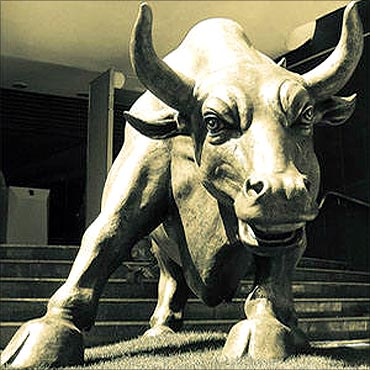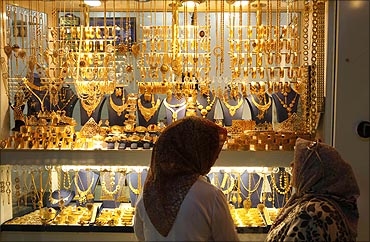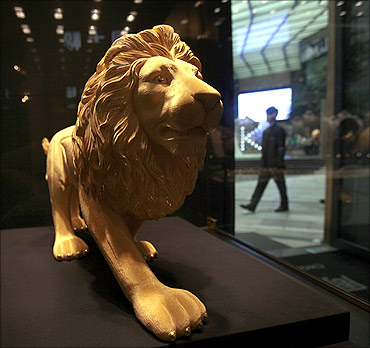Photographs: Reuters. Chandan Kishore Kant, Dilip Kumar Jha & Rajesh Bhayani
With fears of a slowdown looming, a steep fall in world's markets last week and the US being downgraded first the time in seven decades, domestic retail investors have made losses in their most-favoured schemes this year.
Indian investors accessing equities through the mutual fund route have been sitting on negative returns in the country's top-ten equity schemes this year. The year-to-date (YTD) loss is in the range of 8-25 per cent.
However, a positive amid negative factors that should give some cushion to investors is that a majority of the most-favoured equity schemes has performed better than benchmarks and beaten BSE Sensex and CNX Nifty.
. . .
US credit downgrade: Impact on MFs, gold
Image: Negative returns.India's largest equity fund HDFC Top 200, which has assets under management of Rs 10,507.61 crore as on June 30, has given a negative return of 11.37 per cent so far this year, while the third-largest, Reliance Growth, has fallen short of its benchmark, with a negative return of 14.85 per cent. Similarly, returns in Reliance Regular Savings Equity and Fidelity Equity stand at -13.23 per cent and -10.94 per cent, respectively.
| Dwindling fortunes Top 10 equity schemes on the basis of AAUM as on on June 30 | |||||
| Scheme | AAUM (Rs cr) Jun 30, '11 | Fund YTD Return (%) | NAV | Benchmark | Benchmark YTD Return (%) |
| HDFC Top 200 | 10,507.61 | -11.37 | 200.004 | BSE 200 | -15.01 |
| HDFC Equity | 9,220.20 | -10.67 | 266.661 | S&P CNX 500 | -14.58 |
| Reliance Growth | 6,957.75 | -14.85 | 426.429 | BSE 100 | -14.69 |
| Magnum Taxgain | 5,224.14 | -13.33 | 56.57 | BSE 100 | -14.69 |
| Franklin India Bluechip | 3,841.20 | -10.29 | 204.843 | BSE Sensex | -15.62 |
| ICICI Prudential Dynamic | 3,814.40 | -8.42 | 102.197 | S&P CNX Nifty | -15.05 |
| Reliance Diversified Power Sector Retail | 3,403.41 | -25.64 | 61.584 | India Power Index | - |
| Reliance Regular Savings Equity | 3,332.17 | -13.23 | 28.845 | BSE 100 | -14.69 |
| UTI Dividend Yield | 3,304.26 | -8.73 | 31.27 | BSE 100 | -14.69 |
| Fidelity Equity | 3,302.23 | -10.94 | 33.802 | BSE 200 | -15.01 |
| YTD and NAV as on 05th August 2011 Open-ended Equity funds have been considered Source: Value Research | |||||
US credit downgrade: Impact on MFs, gold
Image: Growth to be stalled.Retail investors have already distanced themselves from direct dealing in the stock markets for quite some time now, amid uncertain economic scenario - domestically as well as globally.
US credit downgrade: Impact on MFs, gold
Image: Markets may fall further.
US credit downgrade: Impact on MFs, gold
Image: Total assets fall.This is evident from the dwindling number of folios and abysmal inflows in the equity schemes.
In the first quarter of the current financial year, net inflows stood at less than Rs 500 crore.
In June, the figures dropped to as low as Rs 20 crore, against over Rs 1,500 crore in May.
Overall, the equity assets have reduced to 25 per cent of the industry's total assets in June, compared with 29 per cent at the end of March.
Click NEXT to read the impact on gold...
Gold to be a safe bet
Image: Reuters.Even after the 2008 crisis, gold has been the best performer among all assets class, giving 100 per cent return. Several central banks, led by those of China and India, bought gold in the past one or two years.
Gold to be a safe bet
Image: Reuters.There are no equally big comparable economies where investment can be shifted as the US.
However, according to Gnanasekar Thiagarajan of Commtrendz Research, "central banks will start looking at gold as an alternate. Incremental reserve investment and diversification decisions could weigh higher in favour of gold." He includes the BRIC (Brazil, Russia, India, China) nations in this.
US credit downgrade: Impact on MFs, gold
Image: People would like to invest their savings in an asset class.
Gold to be a safe bet
Image: Reuters.Those who look for near-term weakness cited the potential for more selling of gold to meet margin calls and cover losses in other markets, as was reported during a decline from record highs last Thursday, when equities tumbled.
The market participants also cited potential for a technical correction in the market, with buyers perhaps hesitant to keep rushing in at the highs without some sort of pullback.
Gold to be a safe bet
Image: Reuters.According to the World Gold Council, an independent association of gold producers, the US was hoarding 8,133 tonnes of gold in June, followed by Germany with 3,401 tonnes.
All the world's central banks together have stockpiles weighing 27,300 tonnes. Adding these to the International Monetary Fund's holdings and those of the Bank for International Settlements, the total amount kept in reserve is 30,800 tonnes, about a fifth of the 165,000 tonnes estimated to have been mined since record-keeping began.











article